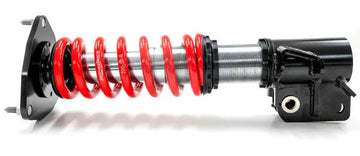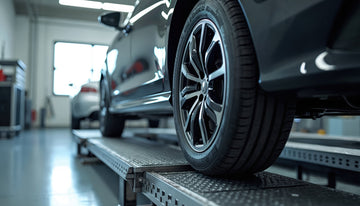The strut foot is a critical component of the suspension system in a car. It is specifically associated with a type of suspension called a strut suspension. The strut foot serves as a connection point between the suspension strut and the vehicle's body or chassis.
In a typical strut suspension, the strut foot is located at the bottom of the suspension strut assembly. It is usually made of durable materials like steel or aluminum and is designed to provide support and stability to the suspension system.
What are the main functions of a strut foot?
Load distribution
The strut foot plays a crucial role in distributing the weight and forces exerted on a damper. It helps transfer the load from wheel knuckle or hub to the strut/damper, ensuring the force of the un-sprung weight of the vehicle is transferred to the strut/damper.
Alignment adjustment
Some strut foot designs allow for limited adjustments in suspension alignment, such as camber and caster angles. These adjustments help optimize tire contact with the road surface, improve handling, and ensure even tire wear.
Noise and vibration isolation
The strut foot may incorporate components like rubber or polyurethane bushings that act as a cushion and reduce noise and vibrations transferred from the suspension strut to the vehicle's body or chassis. This helps minimize noise and improves overall ride quality.
Strut Foot and Alignment: Importance and How to Ensure Proper Alignment
Proper alignment of the strut foot is crucial for the optimal performance and longevity of your suspension system. It ensures stability, tire wear, and overall driving experience. During the installation of the strut foot, it's important to follow manufacturer guidelines and consult a qualified mechanic to ensure precise alignment and proper installation of components. Regular maintenance is key to ensuring alignment. Inspect the strut foot for wear, damage, or misalignment, and clean it regularly to prevent premature wear. Lubricate specific points if necessary and avoid excessive impact when driving. Professional inspection and prompt replacement when needed will maintain the safety and performance of your suspension system. Always refer to your vehicle's manual for recommended maintenance procedures and intervals.
Strut Foot Inspection: How to Identify Signs of Wear and Damage
Signs of wear on a strut foot can manifest in various ways. Here are some common signs that may indicate wear or damage to the strut foot:
Noise
A worn or damaged strut foot can produce clunking, knocking, or creaking noises, especially when driving over bumps or rough surfaces. These noises may indicate that the rubber bushings or bearings within the strut foot are deteriorating or have become loose.
Excessive vibration
If you notice an increase in vibration transmitted through the steering wheel or the vehicle's body, check all suspension components including the strut foot, which may show signs of wear.
Poor handling and stability
A worn or faulty strut foot can negatively impact the handling and stability of the vehicle. You may experience a loss of control, excessive body roll during turns, or a vague steering feel. These issues arise when the strut foot can no longer properly support the suspension strut, resulting in compromised stability and handling characteristics.
Uneven tire wear
If the strut foot is worn or damaged, it may cause the suspension to be misaligned. Misalignment can lead to uneven tire wear, with certain areas of the tire wearing out faster than others. Keep an eye out for signs of uneven tread wear, such as feathering or excessive wear on one side of the tire.
Leaking or visible damage
Inspect the strut foot visually for any signs of leakage or visible damage. If you notice oil or fluid leaking from the strut foot, it may indicate a seal failure or damage to internal components. Additionally, if the strut foot shows signs of physical damage, such as cracks, breaks, or deformation, it should be replaced.
It's important to note that some of these symptoms can also be caused by other suspension components, so a professional inspection by a qualified mechanic is recommended to accurately diagnose the issue.
Strut Foot Maintenance: Tips for Extending the Lifespan of Your Strut Feet
Maintaining the strut foot is essential for the optimal performance and longevity of your suspension system. Here are some maintenance tips to help keep your strut foot in good condition:
Inspect and clean it regularly
Periodically inspect the strut foot for any signs of wear, damage, or leakage. Look for cracks, tears, or visible deterioration of the rubber bushings, as well as any oil or fluid leaks. If you notice any abnormalities, it may be necessary to replace the strut foot.
During routine car washes or maintenance, pay attention to the strut foot. Clean off any dirt, debris, or corrosive substances that may accumulate on the mount. This will help prevent premature wear and maintain its functionality.
If necessary, lubricate it
Some strut foot designs may have specific points that require lubrication. Consult your vehicle's owner manual or manufacturer guidelines to determine if lubrication is necessary and the appropriate lubricant to use. Lubrication helps reduce friction and can extend the lifespan of the strut foot.
Avoid excessive impact when driving
Try to avoid driving over potholes, speed bumps, or other severe road obstacles at high speeds. Excessive impact can place excessive stress on the strut foot and lead to accelerated wear or damage. Drive cautiously and be mindful of road conditions.
Get it inspected professionally
It's recommended to have your suspension system, including the strut foot, inspected by a qualified mechanic during routine maintenance or if you notice any concerning symptoms. A professional can assess the condition of the strut foot and address any potential issues promptly.
Replace it when needed
If the strut foot shows signs of significant wear, damage, or fails inspection, it is crucial to replace it. Continuing to use a worn or faulty strut foot can compromise the safety and performance of your suspension system.
Remember that maintenance practices may vary depending on the specific vehicle make and model. Always refer to your vehicle's owner manual for manufacturer-recommended maintenance procedures and intervals. If you are uncertain or uncomfortable performing maintenance tasks yourself, it's best to consult a professional mechanic who can provide expert guidance and assistance.





